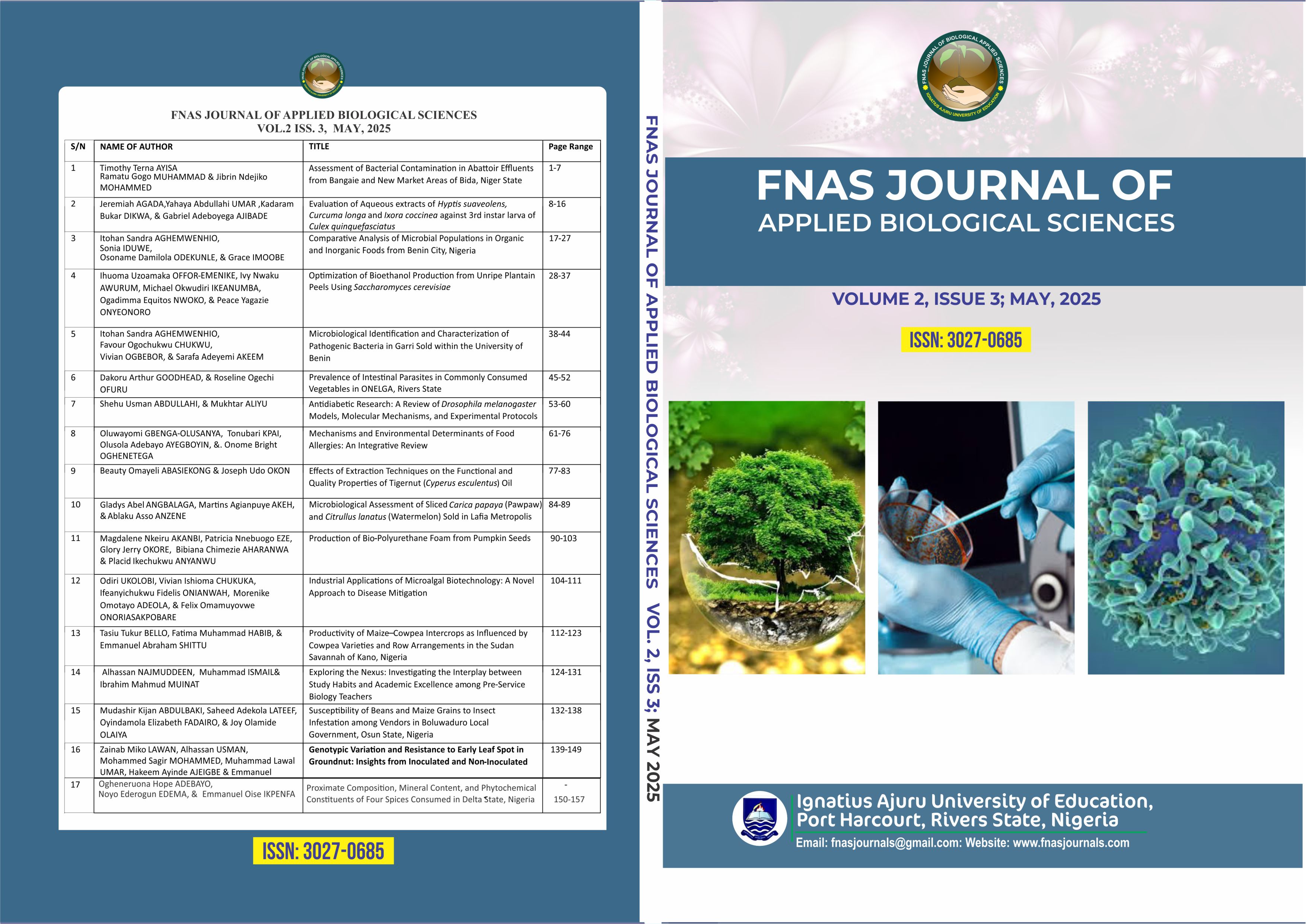Microbiological Identification and Characterization of Pathogenic Bacteria in Garri Sold within the University of Benin
DOI:
https://doi.org/10.63561/jabs.v2i3.931Keywords:
Pathogenic Bacteria, Garri, Food Safety, University of Benin, BacteriaAbstract
Garri is one of the processed cassava products. It is a staple cuisine for most people in southern Nigeria and is consumed widely throughout West and Central Africa. Nigeria alone produces an estimated ten million tons annually. Processing conditions and storage containers have the ability to act as growth enhancers for bacteria and fungi, resulting in microbial contamination of garri. Pathogenic bacteria and opportunistic pathogens can create toxins and other metabolites that can result in infectious diseases, which are one of the main causes of death globally each year. For this reason, it is crucial to have extremely sensitive, specific, and quick approaches for identifying and managing foodborne infections as possible health hazards. In the University of Benin, the student market (June 12 market) is the place where different foodstuffs like rice, beans, yams, garri etc are made available for students’ consumption and the hygiene practices of the market sellers is of great concern. Data on the attitude and knowledge regarding hygiene and sanitation level of the food handlers actively selling in the market was unknown, hence the need to conduct a research on the hygiene, sanitation and microbiological quality of the food handlers in the market, (June 12 market) University of Benin. The following bacteria , B. cereus, Salmonella, Shigella, E. coli were isolated from garri samples obtained from the student market at the University of Benin. The findings of the observation indicated that there were a lot of pathogenic bacteria in the food sample (garri), which may have been caused by the market workers’ poor hygiene and sanitization standards, as well as those of the distributors and processors. These bacterial pathogens can be prevalent in a particular geographical location though they could arise anywhere based on hygiene standard of food handlers at all levels.
References
Adebayo, B.A., Nanam, T.D., Bamidele, E.A., & Braima, D.J. (2012). Quality management manual for the Production of garri. International Institute of Tropical Agriculture (IITA) Ibadan, Nigeria, 8, 1–41.
Akindele, S.T., & Abimbola, W.A. (2018). Microbial evaluation of garri sold in Ijebu community. IOSR Journal of Environmental Science, Toxicology and Food Technology (IOSR-JESTFT), 12(7), 35–38.
Awoyale, W., Oyedele, H., Adenitan, A.A., Alamu, E.O., & Maziya-Dixon, B. (2021). Comparing the functional and pasting properties of garri and the sensory attributes of the eba produced using back slopped and spontaneous fermentation methods. Cogent Food and Agriculture, 7(1), 188–197. DOI: https://doi.org/10.1080/23311932.2021.1883827
Chinwe, O.U., Ozumba, I.C., Adejumo, O.A., Ayuba, O.L., Nwosu, C., Bosa, S.O., & Idowu, O. (2016). Sensory and comparative analysis of ordinary garri and cocos garri (Nutritionally enriched). International Journal of Research Studies in Agricultural Sciences (IJRSAS), 2(8), 27-32. DOI: https://doi.org/10.20431/2454-6224.0208004
Elshafei, A.M. (2017). Role of microorganisms in food contamination, processing and safety. Journal of Food Microbiology, 1(1), 1-2.
Food and Agriculture Organization (FAO) (2010). Agriculture Statistics for Food and Agriculture Organization. News Bulletin.
Li, Y., Yang, X., Zhang, H., Jia, H., Liu, X., Yu, B., & Yang, D. (2020). Prevalence and antimicrobial susceptibility of Salmonella in the commercial eggs in China. International Journal of Food Microbiology, 325, 108623. Liu, Y., Cao, Y., Wang, T., Dong, Q., Li, J., & Niu, C. (2019). Detection of 12 common food-borne bacterial pathogens by TaqMan real-time PCR using a single set of reaction conditions. Frontiers in Microbiology, 10, 222. DOI: https://doi.org/10.3389/fmicb.2019.00222
Obi, P.U., Mohammed, Y.M., Okeke, K.S., Ibrahim, N.J., Ajayi, M.A., Benedict, A.U., & Umar, M. (2022). Microbial analysis and sensory attributes of garri produced and marketed in Bida, Niger State, Nigeria. Journal of applied Science and Environmental Management, 26 (6), 1007-1013 DOI: https://doi.org/10.4314/jasem.v26i6.3
Ogbonna, I.O., Agbowu, B.I., & Agbo, F. (2017). Proximate composition, microbiological safety and heavy metal contaminations of garri sold in Benue, North-Central Nigeria. African Journal of Biotechnology, 16 (18), 1085-1091. DOI: https://doi.org/10.5897/AJB2016.15841
Okafor Arthur, C., Aquaowo Uwakmfon, A., Ojiagu Kingsley, D., & Agu Kingsley, C. (2018). Preliminary studies on processed Garri as a source of bacterial hazards to students. Immunology and Infectious Diseases, 5(3), 25-29. DOI: https://doi.org/10.13189/iid.2017.050301
Okolo, E., & Makanjuola, A.T. (2021). Microbial evaluation of garri sold within Ahmadu Bello University main campus, Samaru, Zaria, Kaduna State. Science World Journal, 16(3), 259-265
Oluwafemi, G.I. , & Udeh, C.C. (2016). Effect of fermentation periods on the physicochemical and sensory properties of garri. IOSR Journal Environmental Science Toxicology and Food Technology, 10 (1), 37- 42.





